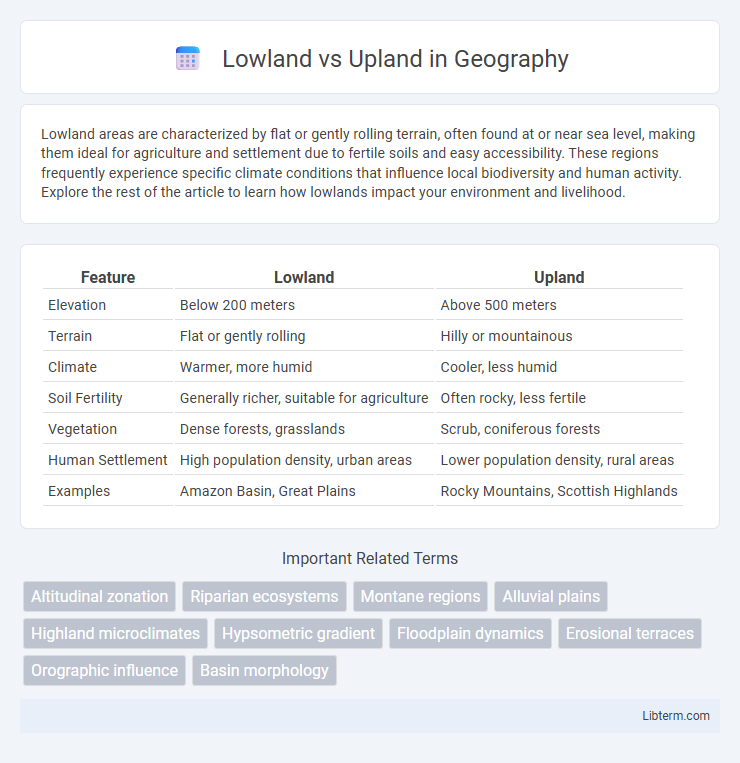Lowland areas are characterized by flat or gently rolling terrain, often found at or near sea level, making them ideal for agriculture and settlement due to fertile soils and easy accessibility. These regions frequently experience specific climate conditions that influence local biodiversity and human activity. Explore the rest of the article to learn how lowlands impact your environment and livelihood.
Table of Comparison
| Feature | Lowland | Upland |
|---|---|---|
| Elevation | Below 200 meters | Above 500 meters |
| Terrain | Flat or gently rolling | Hilly or mountainous |
| Climate | Warmer, more humid | Cooler, less humid |
| Soil Fertility | Generally richer, suitable for agriculture | Often rocky, less fertile |
| Vegetation | Dense forests, grasslands | Scrub, coniferous forests |
| Human Settlement | High population density, urban areas | Lower population density, rural areas |
| Examples | Amazon Basin, Great Plains | Rocky Mountains, Scottish Highlands |
Introduction to Lowland and Upland
Lowland regions are characterized by flat or gently rolling terrain, typically situated at lower elevations near sea level, facilitating agriculture and dense human settlement. Upland areas feature higher elevations with hills or mountains, often marked by cooler climates and distinct ecosystems compared to lowlands. These contrasting landscapes influence biodiversity, climate patterns, and land use, shaping environmental and socio-economic conditions.
Defining Lowland Regions
Lowland regions are characterized by their relatively flat terrains and low elevation, typically found below 500 meters above sea level, often adjacent to coastlines, river basins, or floodplains. These areas exhibit fertile soils due to sediment deposition, supporting intensive agriculture and dense human settlements. In contrast, upland regions are defined by higher elevations, rugged landscapes, and cooler climates, often featuring hills or mountains.
Defining Upland Regions
Upland regions are characterized by elevated terrain, typically ranging from hills to low mountains, with altitudes generally between 500 and 2,000 meters above sea level. These areas often feature rugged landscapes, cooler temperatures, and distinct vegetation compared to surrounding lowland regions. Upland zones influence local climate patterns and serve as crucial watersheds for rivers originating from higher elevations.
Geographic Differences: Lowland vs Upland
Lowland areas are characterized by flat terrain, lower elevation, and proximity to sea level, often featuring fertile soils and extensive river systems that support agriculture and dense human settlements. Upland regions have higher elevations, rugged landscapes, and cooler climates, typically consisting of hills, plateaus, or mountains with less arable land but rich biodiversity and natural resources. These geographic differences impact climate, vegetation, soil composition, and land use patterns distinctively between lowland and upland zones.
Climate Variations Between Lowland and Upland
Lowland areas typically experience warmer temperatures and higher humidity due to their lower elevation, resulting in milder winters and hotter summers compared to upland regions. Upland zones, characterized by higher altitudes, tend to have cooler temperatures, increased precipitation, and more frequent frost, influencing distinct vegetation and agricultural practices. These climatic variations significantly impact biodiversity, water availability, and human habitation patterns between lowland and upland environments.
Biodiversity and Ecosystems in Lowland and Upland
Lowland ecosystems host rich biodiversity with diverse wetlands, floodplains, and tropical forests supporting numerous plant and animal species adapted to warmer, wetter conditions. Upland regions feature distinct ecosystems characterized by cooler temperatures, varied terrain, and specialized flora and fauna such as coniferous forests and alpine meadows. Differences in altitude drive unique ecological processes, promoting diverse species composition and habitat specialization between lowland and upland areas.
Human Settlements and Cultural Impacts
Lowland regions, characterized by fertile soil and easier access to waterways, have historically supported dense human settlements and intensive agriculture, fostering diverse cultural developments and trade networks. Upland areas, with their rugged terrain and limited arable land, tend to host smaller, more isolated communities that maintain distinct cultural traditions and rely on pastoralism or specialized resource extraction. The contrasting environmental conditions of lowlands and uplands shape settlement patterns, economic activities, and cultural identities, influencing linguistic diversity, social organization, and architectural styles.
Economic Activities in Lowland vs Upland Areas
Lowland areas support intensive agriculture such as rice, wheat, and cash crops due to fertile soil and easier irrigation, driving economies focused on farming, trade, and urban development. Upland regions emphasize activities like livestock grazing, forestry, and mining, benefiting from mineral resources and less arable land but supporting tourism and artisanal industries. Economic diversification in uplands helps balance resource extraction with conservation, while lowlands concentrate on high-yield crop production and industrial expansion.
Environmental Challenges and Conservation
Lowland regions face environmental challenges such as flooding, wetland degradation, and biodiversity loss due to agriculture and urban expansion. Upland areas encounter soil erosion, deforestation, and habitat fragmentation driven by logging and grazing activities. Conservation efforts in both zones prioritize restoring native vegetation, protecting endangered species, and implementing sustainable land management to mitigate climate change impacts.
Conclusion: Key Comparisons and Insights
Lowlands typically feature lower elevations, fertile soils, and higher population densities, making them ideal for agriculture and urban development, while uplands consist of higher elevations with rugged terrain, limited arable land, and sparser populations. Climate variations between lowlands and uplands affect vegetation and biodiversity, with uplands often hosting unique ecosystems due to cooler temperatures and greater precipitation. Understanding these distinctions is essential for sustainable land use planning, natural resource management, and addressing environmental challenges in diverse geographic regions.
Lowland Infographic

 libterm.com
libterm.com